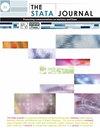graphiclasso: Graphical lasso for learning sparse inverse-covariance matrices
IF 3.2
2区 数学
Q1 SOCIAL SCIENCES, MATHEMATICAL METHODS
引用次数: 0
Abstract
In modern multivariate statistics, where high-dimensional datasets are ubiquitous, learning large (inverse-) covariance matrices is imperative for data analysis. A popular approach to estimating a large inverse-covariance matrix is to regularize the Gaussian log-likelihood function by imposing a convex penalty function. In a seminal article, Friedman, Hastie, and Tibshirani (2008, Biostatistics 9: 432–441) proposed a graphical lasso (Glasso) algorithm to efficiently estimate sparse inverse-covariance matrices from the convex regularized log-likelihood function. In this article, I first explore the Glasso algorithm and then introduce a new graphiclasso command for the large inverse-covariance matrix estimation. Moreover, I provide a useful command for tuning parameter selection in the Glasso algorithm using the extended Bayesian information criterion, the Akaike information criterion, and cross-validation. I demonstrate the use of Glasso using simulation results and real-world data analysis.graphiclasso:学习稀疏逆协方差矩阵的图形套索
在现代多元统计中,高维数据集无处不在,学习大型(逆)协方差矩阵对于数据分析是必不可少的。估计大型逆协方差矩阵的常用方法是通过施加凸惩罚函数来正则化高斯对数似然函数。在一篇开创性的文章中,Friedman, Hastie和Tibshirani (2008, Biostatistics 9: 432-441)提出了一种图形lasso (Glasso)算法来有效地从凸正则化对数似然函数估计稀疏逆协方差矩阵。在本文中,我首先探讨了Glasso算法,然后介绍了一个新的graphiclasso命令,用于大型逆协方差矩阵估计。此外,我还提供了一个有用的命令,用于使用扩展贝叶斯信息标准、赤池信息标准和交叉验证来调优Glasso算法中的参数选择。我通过模拟结果和实际数据分析来演示Glasso的使用。
本文章由计算机程序翻译,如有差异,请以英文原文为准。
求助全文
约1分钟内获得全文
求助全文
来源期刊

Stata Journal
数学-统计学与概率论
CiteScore
7.80
自引率
4.20%
发文量
44
审稿时长
>12 weeks
期刊介绍:
The Stata Journal is a quarterly publication containing articles about statistics, data analysis, teaching methods, and effective use of Stata''s language. The Stata Journal publishes reviewed papers together with shorter notes and comments, regular columns, book reviews, and other material of interest to researchers applying statistics in a variety of disciplines.
 求助内容:
求助内容: 应助结果提醒方式:
应助结果提醒方式:


